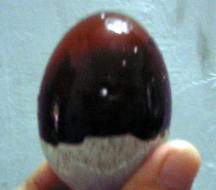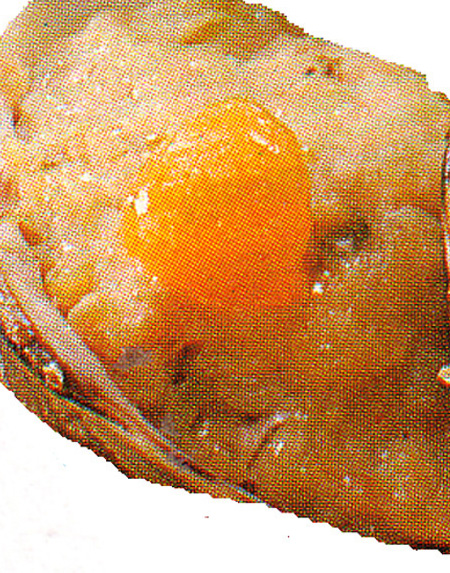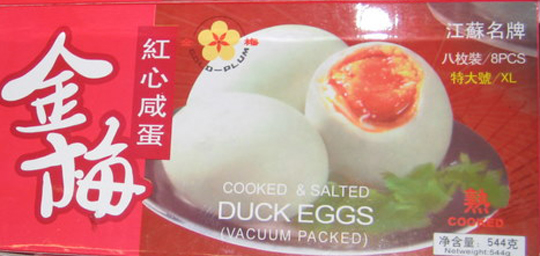
| What is Flavor and Fortune? |
| How do I subscribe? |
| How do I get past issues? |
| How do I advertise? |
| How do I contact the editor? |
Read 7003380 times
Connect me to:
| Home |
| Articles |
| Book reviews |
| Letters to the Editor |
| Newmans News and Notes |
| Recipes |
| Restaurant reviews |
| Article Index (all years, slow) |
| List of Article Years |
| Article Index (2024) |
| Article Index (last 2 years) |
| Things others say |
| Related Links |
| Log In... |
| Authors |
| Categories & Topics |
Eggs: Their Roles and Preservation
| by Jacqueline M. Newman |
Eggs
Winter Volume: 2008 Issue: 15(4) page(s): 28, 29, and 30
Eggs of all kinds, prepared in all manner of ways, play major roles for the Chinese be it in their folk religion or in their food. That, and eggs from different animals have different tastes, different culinary abilities, even different divinations; the latter an item for a different magazine. Eggs used in this cuisine, for the most part, are from poultry; but there are eggs from creatures of the sea and from four legged critters. For folks of many cultures, the Chinese included, eggs are a symbol of fertility; and they are items of marital moments.
For the Chinese, a few common cultural roles for eggs include their use to wash a bride before her wedding ceremony, and for use as gifts to guests at a wedding. At that moment, they are to wish for a child or children of this union. Long after a wedding, when getting one, it advises the earlier wishes became reality, they are to announce the birth of a child.
In the culinary arena, eggs have many uses. They flavor foods, thicken them, bind them, and perform other functional feats. Eggs can be used fresh or cooked, and they can be preserved in many ways. What some say can not be done with eggs is to keep them for very long periods of time. However, on a very early trip to China, circa 1978, hundreds of thousands of them were found stored fresh and frozen, kept for months if not years.
This article explores and limits itself to writing about eggs from poultry with much emphasis on eggs preserved for later use. A few hundred years ago, eggs were more expensive than most vegetables, so it was important to preserve them for use in special ways and for special occasions. No one wanted a single egg to spoil. They needed to be stored and/or preserved. In the short term, people did cook them in one of multiple ways including by steaming, boiling, frying, stir-frying, etc. However, these techniques were of little value for the long-term.
Cleverly, the Chinese found ways to preserve eggs for months. The two most common ways that were done was to put them in a heavy brine solution or to bury them in one of several mixtures. Both of these techniques changed the texture and the taste of the eggs, and made them usable months later.
Long-time readers may remember Irving Beilin Chang's article titled: Duck Boys, Duck Eggs, and Egg Chemists. It appeared in 2002 in Volume 9(1) on pages 9 and 10. He explained collecting and burying duck eggs. Chicken, duck, goose, pigeon, even turtle eggs can be preserved in similar manners. Those buried in their shells are commonly called thousand-year-eggs. In fact, they are buried up to one hundred days. Often buried in a mixture of mud, salt, rice chaff, lime, and ash, these eggs can be packed in other mixtures. When unburied and washed, eggs preserved this way can be used immediately or coated with oil and stored for some time longer. With the advent of refrigeration, these eggs can be refrigerated for months.
 When ready to use these so-called thousand-year eggs, one should remove and wash away all coating materials, then peel them. They can be eaten without cooking, simply cut them in halves or quarters or even in smaller pieces. They can be eaten at this point as is, or cooked in any number of ways in a variety of dishes. Nowadays, these eggs are buried for shorter times, some only thirty to sixty days. The best ones are still buried around ninety days. When washed and shelled, whites are virtually solid and grey-ish black. The yolks, almost coagulated, are blackish-green and a tiny bit soft in their centers.
When ready to use these so-called thousand-year eggs, one should remove and wash away all coating materials, then peel them. They can be eaten without cooking, simply cut them in halves or quarters or even in smaller pieces. They can be eaten at this point as is, or cooked in any number of ways in a variety of dishes. Nowadays, these eggs are buried for shorter times, some only thirty to sixty days. The best ones are still buried around ninety days. When washed and shelled, whites are virtually solid and grey-ish black. The yolks, almost coagulated, are blackish-green and a tiny bit soft in their centers.
Another favorite egg preservation technique is simpler and quicker. Commonly, eggs are put in a jar along with a heavy brine solution. They are kept in this concentrated salt solution for about thirty days. Some can be packed in ceramic buckets in a mixture of charcoal and brine. Eggs made these ways have whites that remain loose and liquid; they do not change color. The yolks become deep yellow and thicken considerably. Some say the yolks resemble mushy apricots, a visual we do not see. It is important to know that any of these salted eggs must be cooked before they eating them. This is important because they can and often do have high bacteria counts. Before eating eggs stored in brine, they should be hard-cooked, cooked in congee, or mixed into another dish that will cook for fifteen minutes, be it a soup or congee, or cook them ten minutes in a stir-fried dish.
 There are pictures, old and new, of thousand year and salted duck eggs with single and double yolks. The egg pictured above is one often called a thousand year egg. The one to the left is a salted egg made with pork in a clam shell. Preserving eggs soaking them in salt water or burying them is not new to the Chinese. There are records of preparing them these ways using duck eggs that are dated from Han Dynasty times (206 BCE to 220 CE). In the 11th century, other records discuss this technique using soft-shelled turtle eggs.
There are pictures, old and new, of thousand year and salted duck eggs with single and double yolks. The egg pictured above is one often called a thousand year egg. The one to the left is a salted egg made with pork in a clam shell. Preserving eggs soaking them in salt water or burying them is not new to the Chinese. There are records of preparing them these ways using duck eggs that are dated from Han Dynasty times (206 BCE to 220 CE). In the 11th century, other records discuss this technique using soft-shelled turtle eggs.
 Eggs in the shell can stay in a brine for some months, but when removed from their shells, they must be refrigerated and cooked in a day or two, at most. Thousand year eggs are rarely kept after they are peeled, though we have refrigerated cut ones for a day or two, at most.
Eggs in the shell can stay in a brine for some months, but when removed from their shells, they must be refrigerated and cooked in a day or two, at most. Thousand year eggs are rarely kept after they are peeled, though we have refrigerated cut ones for a day or two, at most.
One question repeatedly asked is why are salted eggs and thousand-year eggs most often made with duck eggs? One answer, duck eggs taste great made these ways. One can find pigeon eggs made either way, and occasionally, even chicken eggs preserved either of these ways. Others tell us that pigeon and quail eggs taste better made either of these ways; so do turtle eggs. The latter are hard to find, and that may be why almost no one comments on them. We have never made turtle eggs either of these ways, so we can not speak from personal experience; have you?
Another question frequently asked is: Do people still make salted duck eggs at home? A few surely do, but the cost of buying the eggs and other ingredients virtually equals the price of purchasing them. Not one Chinese person we asked said they do, and to a person, all said they can not differentiate those made at home from those purchased. Should you want to make salted duck eggs, a recipe follows. If making pigeon or quail eggs, use six dozen in place of the one dozen duck eggs called for in the recipe.
One last thing important to know about duck eggs is that they do not hold a foam as do chicken eggs. Therefore, the whites of duck eggs can not be whipped or beaten stiff; but they and all eggs can be fried with or without beating. Some say duck eggs taste too strong so do not use them when baking. Truth be told, do not know anyone who uses raw duck or raw goose eggs in any bakery product. However, a chicken farmer friend says his family likes both kinds fried, preferably scrambled and mixed with an equal volume of chicken eggs.
The recipes that follow are for making and using salted eggs. Consult the index for other recipes that use thousand day eggs.
MAKING SALTED DUCK EGGS at home begins with washing the eggs, then placing them in a jar or ceramic container. The ratio of duck eggs to salt is usually ten duck eggs to one cup of salt, this mixed with seven cups of warm water. After the salt dissolves and the water is at room temperature, add the eggs.
My friends recommend adding half cup of Shaoxing rice wine and a tablespoon or two of Sichuan peppercorn pre-blanched in boiling water for one minute. Before adding the eggs, stir well until all the salt has dissolved, and when it has, close the jar loosely and put it in a cool place. Do not open it for at least the first three weeks. If not using wine when making yours, increase the amount of salt by 50% to one and a quarter cups of salt to seven cups of warm water.
COOKING SALTED DUCK EGGS, is a must if not putting them into a soup or a stir-fry dish where they will be cooked for many minutes. So to cook them, put them into a pot, cover them with cold water, and slowly bring the water almost to the boiling point. Turn the heat down and if they are duck eggs, simmer them for eight minutes. If cooking pigeon or quail eggs, simmer them for five minutes.
| Steamed Three Eggs |
|---|
3 salted eggs 3 thousand-year eggs, exterior black materials removed, and washed 3 fresh eggs 1 teaspoon Chinese rice wine 1/4 to 1/2 teaspoon coarse salt 1 teaspoon sesame oil Preparation: 1. Wash, then peel salted eggs. Using chop sticks or two knives, break up the yolk into small pieces. Wash and peel the thousand year egg, and dice into half-inch pieces. Mix these two eggs together in a bowl. 2. Beat the fresh eggs, and mix them into the bowl with the other two sets of eggs. Add the rice wine and salt, and mix again. 3. Use the sesame oil to coat a glass loaf pan, and pour out any excess and mix in with the eggs; then pour them into this pan and cover with plastic wrap. 4. Put in a microwave oven, and cook on medium for ten to fifteen minutes or until set. Then slice pieces about one-quarter inch thick, plate them, and then serve. Note: The egg mixture can be baked in a 300 degree oven or placed in a steamer over boiling water; both need about the same amount of cooking time. |
| Rice with Salted Duck Eggs |
|---|
1 pound rice, rinsed well 3 salted duck eggs, shells rinsed 1 teaspoon sesame oil 2 sprigs fresh coriander, mince on and most of the stem of the other one Preparation: 1. Put rice and the duck eggs in an automatic rice cooker or prepare as usual if not using a rice cooker, simmering the rice covered for eighteen minutes. 2. Remove the eggs, and recover the rice. Cut the eggs in half and spoon them out of the shell in four or five sections, and mix with the rice. Mix in the minced coriander, then top with the sprig of coriander, and serve. |
| Clams, Pork, and Salted Duck Eggs |
|---|
12 large clams, soaked in cold water for one hour with one teaspoon coarse salt 6 large shrimp, peeled and coarsely minced 1/2 cup hand chopped pork 3 fresh or canned water chestnuts, coarsely minced 3 uncooked salted egg yolks, separated 1 scallion, minced 2 slices fresh ginger, minced 1 teaspoon Chinese rice wine 1/4 teaspoon ground white pepper 1 teaspoon thin soy sauce Preparation: 1. Put clams in boiling water to cover them, and as soon as they open, remove them to a bowl; and reserve their shells. 2. Chop clams and reserve any liquid in their shells. 3. Mix shrimp, pork, water chestnuts, two egg yolks, scallion, rice wine, ground white pepper, and soy sauce and add to the minced clams. 4. Put about two tablespoons clam mixture in a clam shell, and smooth the surface. Repeat until all of the clam mixture has been used. Then put the stuffed clams on a heat-proof plate. Put a small amount of the third salted egg yolk on the center of each stuffed clam. 5. Cover with plastic wrap and microwave on high for four minutes or steam covered and over boiling water for six minutes. Then serve. |
| Chicken and Egg-yolk Rice Rolls |
|---|
3 lotus leaves 1 cup glutinous rice, cooked until soft, about seventy-five minutes 2 Tablespoons lard or melted chicken fat 1 teaspoon chicken bouillon powder 1 teaspoon oyster sauce 1/2 teaspoon mixed salt and ground white pepper 1 teaspoon Chinese rice wine 3 salted egg yolks 1/4 cup coarsely diced chicken, dark meat preferred 4 large shrimp, shells and veins removed, and coarsely diced 2 large soaked Chinese mushrooms, stems discarded, and diced 1 teaspoon sesame oil Preparation: 1. Soak lotus leaves for two hours in warm water, then drain them, and cut each one into quarters. 2. Stir lard, bouillon powder, oyster sauce, salt and pepper mixture, and the rice wine into the rice. 3. Mix egg yolks and the chopped chicken, shrimp, and mushrooms together and put about some of this in a line down the center of the rice. Using the lotus leaf as a helper, roll the rice over the chicken filling. Then roll the entire rice-filled mixture in the lotus leaf closing in the ends while so doing. 4. Oil a heat-proof plate and put the rice rolls on it. Cover with the top section of a bamboo steamer, its cover. Steam for eighteen minutes. Then remove and serve the rice rolls plain or with a dipping sauce such as plum, wasabi, diluted hoisin, etc. |

Copyright © 1994-2024 by ISACC, all rights reserved
Address
3 Jefferson Ferry Drive
S. Setauket NY 11720